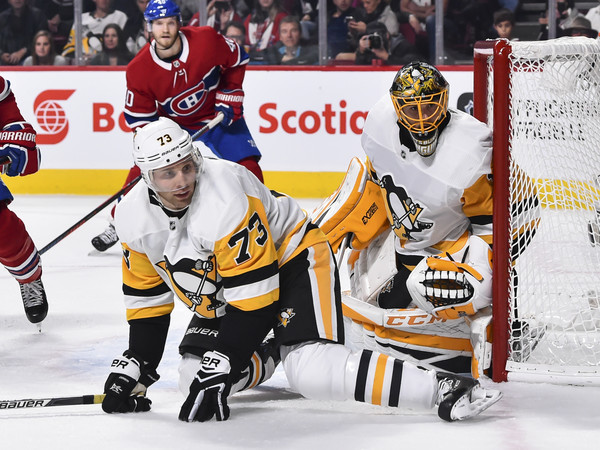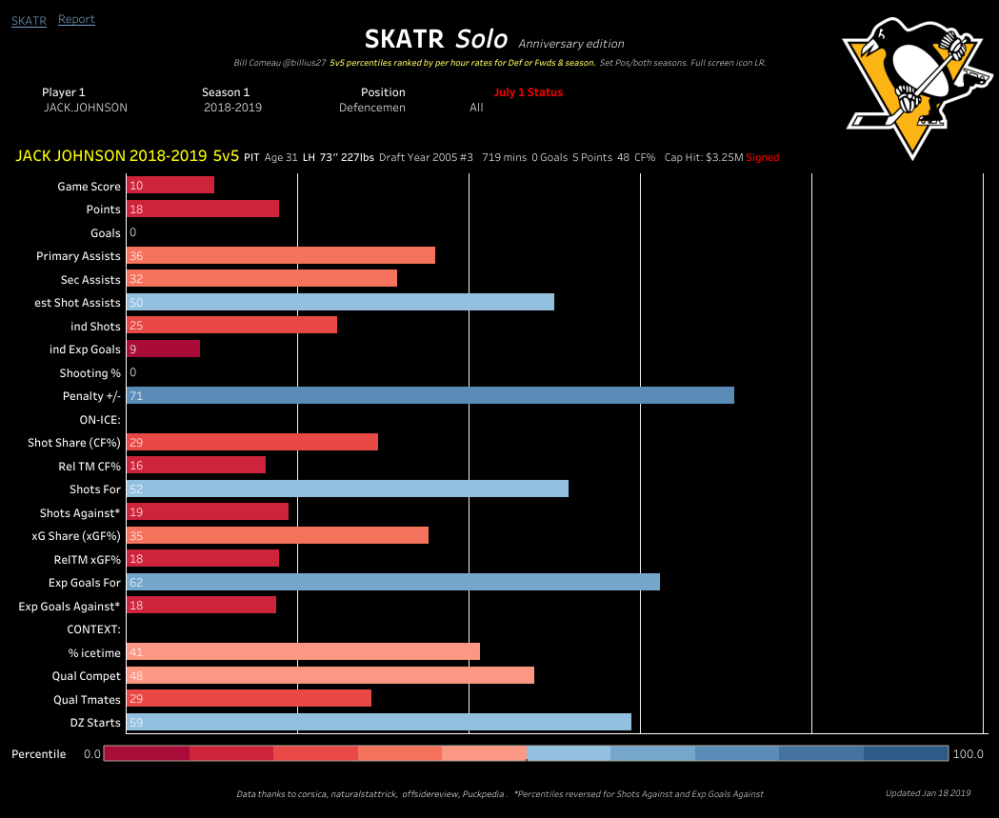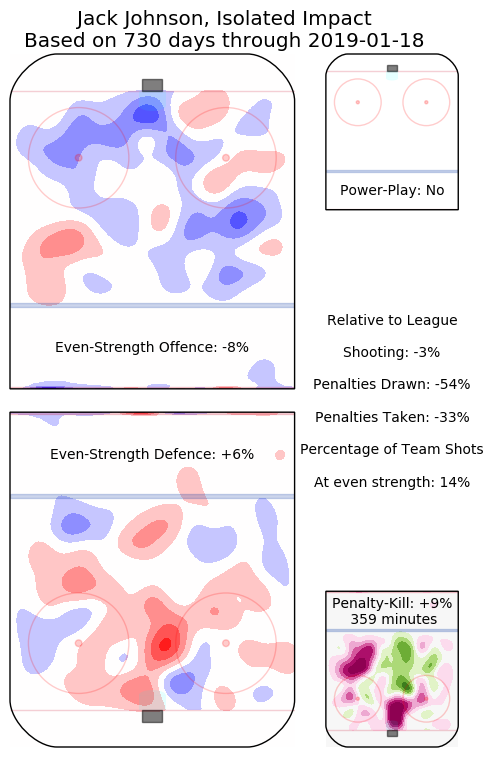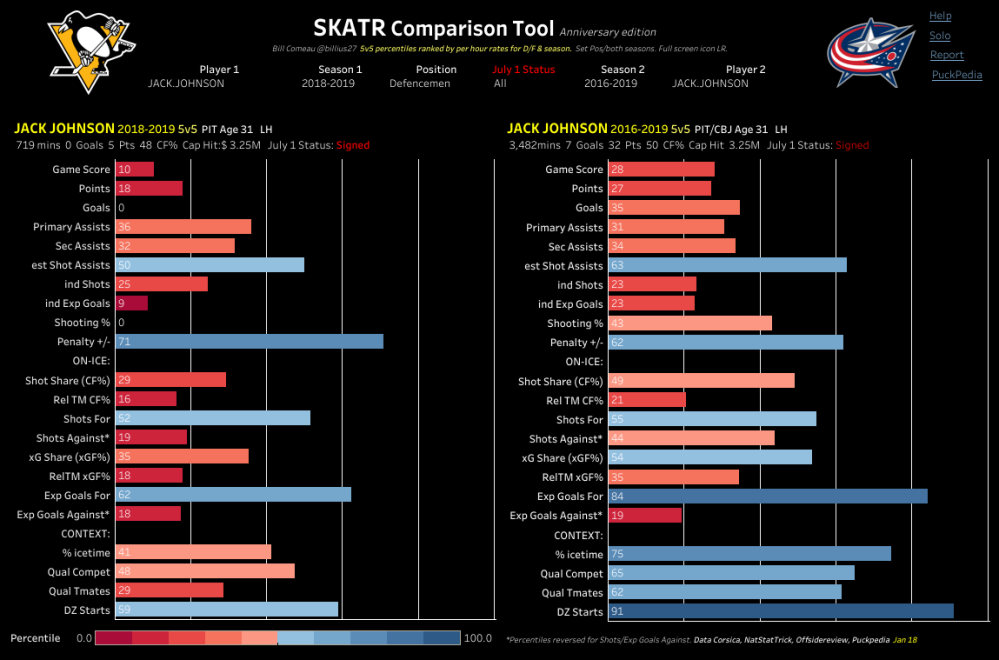
Last Tuesday, we took a look at some numbers surrounding Kris Letang this season. In short, Letang has been nothing shy of incredible this year. So today, I wanted to take a look at a Penguins defenseman at the other end of the spectrum: Jack Johnson.
Now, it’s pretty easy to watch Jack Johnson on a regular basis and come to the conclusion that the much-maligned Penguins defenseman has not had a banner year by any stretch of the imagination this season.
To the naked eye, plays like these have become mainstays in the Penguins lineup since signing his 5 year, $16.25M contract on July 1.
https://twitter.com/G_Off817/status/1074835338357547008
https://twitter.com/G_Off817/status/1062517427148390400
Bearing these plays (and the plethora of others) in mind, it’s impossible to say whether these mistakes are so glaring because they’re that bad or because it’s our general confirmation bias noticing them more. In all likelihood, it’s probably both.
So, I wanted to take a look at his underlying numbers to see if they match what we’ve seen on the ice this year, or even match what Jack Johnson has seen on the ice this year, or see if they paint him in a different light.
Much like we did with Letang on Tuesday, a high level view of Johnson’s season can be seen through Bill Comeau’s SKATR tool to get a quick sense of what we’re looking at here:
At this bird’s eye view, we can see that Johnson is in the top half of the league’s defensemen in just 5 of the 22 categories listed at 5v5: estimated Shot Assists, Penalty Differential, On-Ice Shots on Goal for, On-Ice Expected Goals For, and Defensive Zone Starts. That’s it.
To exist below the 30th percentile in things like on-ice shot attempt share (both raw and relative to his teammates) and expected goals against (also raw and relative) isn’t great on any team. What also isn’t great is finding yourself in the bottom 10% of things like Game Score, which, as the name suggests, is a model which takes a variety of different stats (such as goals, points, shots, shot attempt share, etc.) and weights them to give a play a score for a particular game. In short, 90% of the players in Bill’s sample size for Johnson have a better cumulative Game Score than JJ73.
But, still, let’s take a look at some of those numbers in a little greater detail to see exactly what they tell us about his season thus far to see if we can find something that maybe the viz is missing.
Note: All data herein via Natural Stat Trick unless otherwise noted.
On Ice
First, let’s preface this by establishing that in this section, I’ll be carrying through that we’ll be looking at Johnson’s season this year compared to that of his aggregate 3 years prior (2015-16, 2016-17, 2017-18) to coming to Pittsburgh.
For his 2018-19 NHL ranking throughout, it will be of the same pool of 206 defensemen that have played a minimum of 300 minutes at 5-on-5, just as we looked at with Letang.
With that, let’s take a look at his on-ice shot attempt data at 5v5.
| Category | 2015-2018 | 2018-19 | 2018-19 NHL Rank |
| Shot Attempts For (per hour) | 54.15 | 54.46 | 127th |
| Shot Attempts Against (per hour) | 58.36 | 63.34 | 17th most |
| Shot Attempt Share | 48.13 | 46.23 | 175th |
| Relative Shot Attempt Share | -3.25 | -4.73 | 188th |
Referring back to Bill Comeau’s viz above, these numbers should come as no surprise. Johnson is on the ice for more shot attempts against than he’s on the ice for, and that share of shot attempts puts him firmly at 175 of 206. What’s noteworthy, though, is that he has found himself on the ice for nearly the same rate of shot attempts in the positive direction this season as he did in his previous 3 with the Blue Jackets. However, per 60 minutes of 5v5 ice time, he’s seeing close to 5 more shot attempts being directed at his own net this season. What we also see here is that the Penguins as a team see themselves owning nearly a +5 shot attempt differential when Johnson is off the ice compared to when he is on the ice, just ahead of Juuso Riikola and Olli Maatta (more on them later). What should also be considered here is that, relative to his teammates, Johnson sees 6.42 more shot attempts directed at his net when he’s on the ice versus when he’s not per 60 minutes of 5v5 play. That is a team high among the 7 defensemen on the Penguins that have played 300+ minutes.
Now that we’ve established some things from a shot attempt perspective, how does Johnson stack up when looking at the scoring chance data?
| Category | 2015-2018 | 2018-19 | 2018-19 Rank |
| Scoring Chances For (per hour) | 25.41 | 26.42 | 96th |
| Scoring Chances Against (per hour) | 26.68 | 28.52 | 48th most |
| Scoring Chances Share | 48.78 | 48.09 | 131st |
| Relative Scoring Chance Share | -3.25 | -4.17 | 175th |
| High Danger Scoring Chances For (per hour) | 11.14 | 11.31 | 74th |
| High Danger Scoring Chances Against (per hour) | 10.87 | 12.36 | 42nd most |
| High Danger Scoring Chance Share | 50.61 | 47.78 | 132nd |
| Relative High Danger Scoring Chances Share | -1.74 | -5.40 | 180th |
As it turns out, the same trend continues here. In terms of scoring chances for and high danger chances for, Johnson has seen a slight uptick in both with the Penguins compared to his previous 3 seasons. That shouldn’t totally come as a surprise given that he’s seen more time with Evgeni Malkin than any other Penguin forward. But that remains the lone positive takeaway.
What Johnson has seen is nearly 3 more scoring chances generated against him and his team per hour of ice time this season compared to his previous 3 years. As a result, we see that his share of on-ice scoring chances has gone down 0.69. And, relative to his team, they are worse off by just over 4 scoring chances while he’s on the ice compared to when he’s off it. That -4.17 is actually 4th best on the Penguins (ahead of Oleksiak, Riikola, and Maatta), again largely due to how good Letang and Dumoulin have been. It’s hard to match the pace in which they generate and suppress.
Despite his relative share being better than those 3, Johnson sees his relative scoring chances against per hour at 3.02, again a team-high. This means that the Penguins are giving up 3 more scoring chances per 60 minutes that Johnson is on the ice versus when he’s off of it.
This trend, as you’d imagine, continues in the high danger scoring chance buckets. Again, he’s marginally better off in terms of the HD scoring chances generated by the Penguins while he’s on the ice compared to his previous 3 in Columbus, but his 12.36 against per hour is the 42nd most of that pool of 206 defensemen this season and is 6th worst of the 7 Penguins defensemen that have played 300+ minutes.
What’s important to point out here, too, is that for as much as Maatta, for example, has gotten caved in terms of shot attempts and scoring chances, no one on the Penguins gives up fewer high danger scoring chances than Maatta, while only Pettersson gives up more than Johnson’s 12.36 (more on Pettersson in a bit, too). In fact, relative to the rest of the team, Johnson’s +1.12 HD chances against is also a team-high, following course with his -5.40 relative share of high danger chances against, which finds him last on the Penguins and in 13th percentile among that pool of 206 defensemen.
Finally, let’s wrap up his on-ice performance by digging into the expected and actual goal-based numbers.
| Category | 2015-2018 | 2018-19 | 2018-19 Rank |
| Goals For (per hour) | 2.21 | 2.1 | 151st |
| Goals Against (per hour) | 2.24 | 3.47 | Tied 7th most |
| Goals For Share | 49.65 | 37.68 | 197th |
| Relative Goals For Share | –4.38 | -24.65 | 206th |
| Expected Goals For* | 2.55 | 2.39 | 89th |
| Expected Goals Against* | 2.48 | 2.69 | Tied 27nd most |
| Expected Goals For Share* | 50.69 | 47.05 | 147th |
| Shooting Percentage (on ice) | 7.29 | 7.30 | 145th |
| Save Percentage (on ice) | 92.92 | 89.86 | 183rd |
Note: Expected Goals buckets above come via Corsica Hockey. Remember: expected goals factors in shot type, location, angle, rebounds, rush shots, and game state.
First things first: Jack Johnson is on the ice for an astronomical amount of goals against. Relative to his teammates, his -24.65 share of on-ice goals is the worst in the league. Per hour of 5v5 ice time, only 6 players are on the ice for more goals against than Johnson. This can be attributed to a number of different things. First off, while he’s on the ice, his goalies are simply not making saves. What’s insane about his on-ice save percentage of 89.86% is that it’s far and away the worst of the Pens D group. In fact, of the 7 D-men, not a single one of them has an on-ice save percentage below 92% at 5v5.
So why might this be?
We can hypothesize that it may have something to do with the amount of high danger chances against he is on the ice for. Remember, only 41 of 206 defensemen have been on the ice for more against per hour than Johnson. Johnson has also been on the ice for 2.02 high danger goals against per 60 minutes of ice time, 13th most in the league. It should come as no surprise, then, that we see that his 2.69 expected goals against per hour of ice time is the joint 27th most in the league.
In other words, teams are getting to high percentage scoring areas quite frequently when Johnson is on the ice.
This lends itself to giving us a better idea why teams are scoring at a much higher rate when Johnson is on the ice. While Johnson isn’t getting saves from his goaltenders while he’s out there, he’s also not doing much in the way of limiting his goaltenders from having to face high quality, high danger shots and chances against.
That’s a problem and it shows up when looking at where shots are taken while Johnson is on the ice (via Micah Blake McCurdy’s shot location viz):
All of that red at the bottom in and around the slot/low slot is bad as that is where the shots are coming from. Compare that to the likes of Maatta and Dumoulin, both of whom do not allow many high danger looks, and it really tells the story: the goalies may have to be better, but so too does Jack Johnson.
And, while we have to acknowledge that Johnson can’t make the saves for the goaltenders, it seems problematic that he is the only Penguins defensemen that can’t get saves at the same rate as the rest of his defensive teammates.
It appears that, while he may be “hard to play against” in the sense that he’s physical (140 hits on the season, 5th most among all defensemen in the league), he’s not “hard to play against” in the sense of actual defending.
Impact on teammates
So, given the data that we just looked at, we can reasonably say a few things:
- Jack Johnson’s poor career numbers leading up to him joining the Penguins may not have totally been because he played on Blue Jackets teams that were less than good;
- Johnson’s numbers with “better teammates” in Pittsburgh are, generally speaking, worse than his 3 years previously in Columbus;
- The Penguins are much better with Jack Johnson off the ice than they are with him on the ice.
With #1 and #2, let’s cycle back to Bill Comeau’s viz to summarize it neatly with Johnson this season (left) vs. his 3 year 2016-19, which includes this season (right). The three year total isn’t a picture of fortune, but even still is much better than what we’ve seen this season.
Now, #3 in mind in particular, it’s worth considering how his teammates fare with him and without him.
And, perhaps no two players have been impacted more by Jack Johnson than Evgeni Malkin and Marcus Pettersson, both of whom have seen 268:04 and 299:16 of ice time respectively with Johnson, most of any Penguins player that isn’t a goalie.
For perspective, Johnson has seen 742:37 of 5v5 ice time this season, 3rd most of any Pens defensemen. Malkin’s 679:13 is 3rd most among Pens forwards, meaning Malkin is seeing ~39.5% of his 5v5 ice time with Johnson. Pettersson, on the other hand, has played 325:48 since being acquired for Daniel Sprong, a clip of ~91.9% with Jack Johnson.
So, let’s take a look at what Johnson’s impact has been on these two.
| Player | Marcus Petterson | Evgeni Malkin |
| TOI With JJ | 399:16 | 268:04 |
| TOI Without JJ | 63:13 | 490:49 |
| Shot Attempt Share With JJ | 48.68 | 49.81 |
| JJ Shot Attempt Share Without Player | 33.57 | 44.33 |
| Shot Attempt Share Without JJ | 51.06 | 50.68 |
| Shot on Goal Share With JJ | 48.32 | 49.12 |
| JJ Shot On Goal Share Without Player | 30.67 | 44.05 |
| Shot on Goal Share Without JJ | 51.85 | 49.32 |
| Goals For Share With JJ | 50.00 | 46.67 |
| JJ Goals For Share Without Player | 33.33 | 32.50 |
| Goals For Share Without JJ | 100.00 | 48.72 |
| Scoring Chance Share With JJ | 51.64 | 53.33 |
| JJ Scoring Chance Share Without Player | 36.49 | 45.91 |
| Scoring Chance Share Without JJ | 47.27 | 53.66 |
| High Danger Scoring Chance Share With JJ | 52.42 | 40.44 |
| JJ High Danger Scoring Chance Share Without Player | 42.86 | 47.62 |
| High Danger Scoring Chance Share Without JJ | 51.72 | 53.89 |
For the purpose of not dragging this out too much, I chose to only select shot attempts, shots on goal, goals, scoring chances, and high danger scoring chances. However, in looking at some other data buckets, a staggering trend is seen just as we can see above: players are better away from Johnson than with him and those same players tend to prop Johnson up, perhaps more than he would be propped up elsewhere.
Specifically with Malkin and Pettersson, this can be seen in great detail. But let’s start with Pettersson and acknowledge just how good he’s been since coming over from the Ducks, despite being anchored to Johnson.
We get a decent idea what Pettersson is capable of by looking at his numbers away from Johnson, albeit through a small 63:13 sample size. When taking Johnson away from Pettersson, you see Pettersson jump to owning a 50%+ share of shot attempts, unblocked shot attempts, shots on goal, goals, and high danger scoring chances. The lone anomaly here is Pettersson’s share of scoring chances actually goes down away from Johnson. Remember when it was mentioned that only 3 players had positive shares of shot attempts, scoring chances, and high danger scoring chances relative to their teammates, with two of them being Letang and Dumoulin? Well, the other is Marcus Pettersson, who, despite the below average numbers with Johnson, actually makes the Pens a better team while he’s on the ice compared to when he’s off of it.
As you’ve probably already guessed, too, Evgeni Malkin has found himself much better in the 490:49 away from Johnson than he has with Johnson. Across the board, Malkin’s share of the above data buckets sees an increase away from Johnson.
Johnson, on the other hand, sees his shares absolutely crater away from those two. Across the board without Pettersson, Johnson sees his share of shot attempts, shots on goal, goals, and scoring chances all fall into the 30-37% range. Only his share of high danger chances crosses the 40% threshold, but 42.86% is far from okay.
Johnson’s drop off without Malkin isn’t quite as drastic, but still very much in the floundering realm. As you’d expect with an elite talent like Evgeni Malkin, he’s going to make players around him better, even if they drag him down in the process.
In fact, when you take a look at all 14 players that have played 100+ minutes of 5v5 time with Johnson, this trend is ever-present.
In terms of share of shot attempts, only Patric Hornqvist (50.16% with Johnson, 49.91% without Johnson) and Tanner Pearson (47.74% with JJ, 45.77% without JJ) see a decrease away from JJ73.
With respect to shots on goal, only Pearson sees a drop off away from Johnson (45.58%) than he sees with Johnson (48.2%), while it’s Pearson (50% with, 45.45% without) and Aston-Reese (66.67% with, 58.82% without) that see a decline in terms of their goals for share.
As mentioned above, Pettersson sees his share of scoring chances drop off away from Johnson, where he is also joined by Phil Kessel (48.15% with, 46.21% without), Derick Brassard (42.55 with, 41.27% without), and Aston-Reese (48.51 with, 45.91 without). Pettersson’s very marginal decrease in share of high danger chances is also there, joined here by Guentzel (61.29% with JJ, 57.36% without), Brassard (43.1% with, 42.86% without), Hornqvist (46.52% with, 54.31% without), and ZAR (55.81% with, 46.27% without).
All that being said, that’s remarkably concerning for so many players to be, in nearly in every data set we have available, that much better away from Johnson than with him.
Now, I don’t claim to know what the solution for Johnson is. He’s been sheltered a bit in comparison to his teammates, starting a team high 49.72% of his shifts in the offensive zone (89 in the offensive zone, 156 in the neutral zone, and 90 in the defensive zone), while also seeing the 2nd most percentage offensive zone faceoffs (48.58% – 206 OZ, 244 NZ, 218 DZ). Additionally, his quality of competition sits in the 48th percentile, despite playing #3 defensemen minutes. Yet he perpetually and continually gets caved in on a regular basis.
But, GMJR went out and got him with a purpose in mind this summer, despite everything pointing to JJ73 being the player then that we’ve seen so far this season. HCMS has a duty to try to figure out what to do with the tools he’s given and, considering the money and term given to Johnson, it’s hard to justify sitting $3.25M in the pressbox. No one can blame him for that.
In that same light, it’s hard to throw much blame on GMJR for having the confidence and belief in his coaching staff that they could shine Johnson up and make him serviceable. To date, they simply haven’t been successful in doing so. Maybe in Years 2 and 3, we see improvement as JJ73 settles in more and more, just as we did with Paul Martin.
Unfortunately, the data doesn’t suggest that to be likely with Jack Johnson and, as it stands right now, the Penguins appear much better off without Johnson than with him.
Things can always change. And hopefully they do.
Add The Sports Daily to your Google News Feed!



